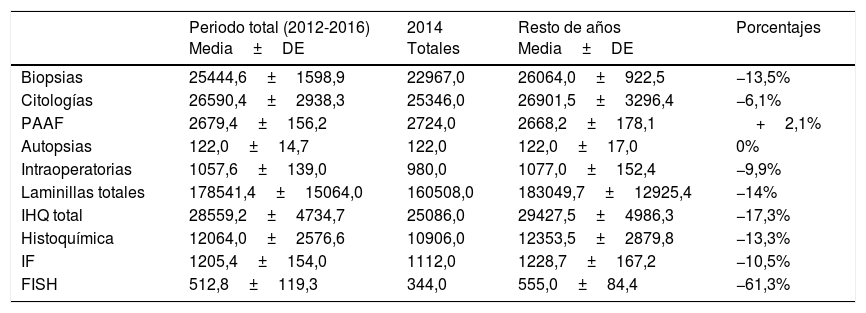Estudiar la evolución de variables de interés de un Departamento de Anatomía Patológica de un hospital de tercer nivel durante la última década. Valorar el impacto del traslado hospitalario en la actividad (año 2014).
Material y métodoEstudio retrospectivo observacional en el que se analizaron las muestras registradas (biopsias, citologías, PAAF, autopsias, intraoperatorias) así como las técnicas complementarias (IHQ, histoquímica, IF y FISH) y la cartera de servicios, durante la década 2007-2016. Para el análisis estadístico se compararon los quinquenios 2007-2011 y 2012-2016.
ResultadosLas siguientes variables han sido estadísticamente significativas: citologías (34055,8±1994,0 vs. 26590,4±2938,3; p=0,002), autopsias (156,2±27,3 vs. 122,0±14,78; p=0,039), inmunohistoquímica (17855,4±3424,2 vs. 28559,2±4734,7; p=0,003), histoquímica (11117,8±2300,9 vs. 6225,0±1330,5; p=0,003) e inmunofluorescencia (610,2±185,3 vs. 1205,4±154,0; p=0,001). Se han identificado correlaciones estadísticas de interés entre las variables. En el año 2014 se observó que las variables de mayor peso específico (biopsias, citologías, IHQ e histoquímica) en la carga asistencial del Departamento mostraron un descenso medio del 12,5%. Se ha identificado un incremento generalizado en el catálogo de muestras disponibles. El número de anticuerpos (78,7%), la histoquímica (38,7%) y FISH (400%) fueron los que mayor aumento mostraron.
ConclusiónSe han identificado variaciones relevantes del volumen de actividad, así como en la cartera de servicios, especialmente en las técnicas orientadas a mejorar la precisión diagnóstica (IHQ e IF); y un descenso importante en el número de citologías, autopsias e histoquímica. En el año 2014 se ha observado un descenso de más del 12% en las principales variables del estudio.
To study the evolution of variables of interest in a department of pathology from a third level hospital during the last decade and to evaluate the impact on these of the hospital relocation in 2014.
Material and methodRetrospective observational study in which the recorded samples (biopsies, cytology specimens, FNA, autopsies, intraoperative) as well as the complementary techniques (IHC, Histochemistry, IF and FISH) and portfolio of services were analyzed during the years 2007-2016 inclusive. For the statistical analysis, the five-year periods 2007-2011 and 2012-2016 were compared.
ResultsThe following variables were statistically significant: cytology (34055.8±1994.0 vs 26590.4±2938.3, p=0.002), autopsies (156.2±27.3 vs 122.0±14.78, p=0.039), immunohistochemistry (17855.4±3424.2 vs 28559.2±4734.7, p=0.003), histochemistry (11117.8±2300.9 vs 6225.0±1330.5, p=0.003) and immunofluorescence (610.2±185.3 vs. 1205.4±154.0, p=0.001). Statistical correlations of interest among variables have been identified. In 2014, it was observed that the variables of greater specific weight (biopsies, cytology, IHQ and histochemistry) in the work load of the Department showed an average decrease of 12.5%. A generalized increase in the panel of available samples has been identified, the largest increase being seen in the number of antibodies (78.7%), histochemistry (38.7%) and FISH (400%).
ConclusionRelevant variations in work volume, as well as the service portfolio, have been identified, especially in the techniques aimed at improving diagnostic accuracy (IHQ and FI), and a significant decrease in the number of cytology specimens, autopsies and histochemistry. In the year 2014 a decrease of more than 12% in the main variables of the study was observed.
Artículo
Comprando el artículo el PDF del mismo podrá ser descargado
Precio 19,34 €
Comprar ahora











